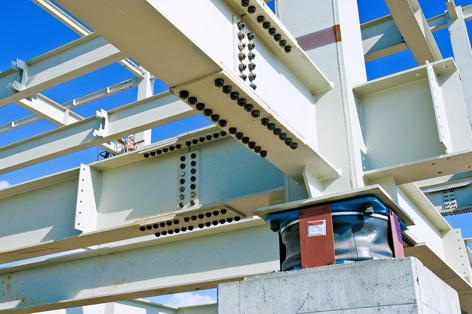
It was said that the financial cost of 2011’s earthquake in Japan - and resulting tsunami and fires - could be as much as US$100 billion1. After the devastating loss of life suffered, this is a huge economic cost to a nation.
Whilst the focus and priority must always be to reduce loss of life (through design codes) more can be done to reduce the economic impact. Damian Grant, Senior Earthquake Engineer at Arup explains how engineers can make a difference by looking beyond code towards damage avoidance design.
The traditional focus in the seismic design of buildings has been on ensuring life safety in a large earthquake. Significant damage is tolerated provided that the building does not collapse and evacuation of occupants is not impeded. As noted in this blog piece by Kubilay Hicyilmaz, there are still many parts of the world where buildings have not been designed to be earthquake resistant, and death tolls are large in even moderate earthquakes. This is not just confined to the developing world – earlier this year, earthquakes in Northern Italy killed 25 people, and left 1000s without homes. In his piece, Kubilay urged engineers and architects to take a leadership role in ensuring that the next generation of houses built in earthquake prone regions of the world are designed to be earthquake resistant.
In parts of the world where seismic design codes are well developed and enforced – such as the United States, Japan and New Zealand – death tolls in earthquakes are generally low, and casualties are mostly a result of the collapse of older building stock that predates modern codes. The 2010 and 2011 earthquakes in Christchurch, New Zealand, claimed 185 victims – not insignificant for a city of only 370,000, but relatively low considering the extreme levels of ground shaking experienced. However, the economic and cultural heritage losses associated with the subsequent large-scale demolition of the Christchurch city centre have been immense, not to mention the disruption experienced in whole residential suburbs that have had to be abandoned due to the risk of further liquefaction or landslides.
The example of Christchurch, and other earthquakes over the last decades in the United States and Japan, is shifting the focus in seismic design of new buildings towards “damage avoidance design” (also referred to as “low damage design”). In this case, the goal is not merely to prevent sudden collapse and consequent human casualties, but also to allow the building to be reoccupied with minimal repair costs following a large earthquake.
Typically this is achieved by designing carefully engineered joints or devices that can accommodate the seismic movements imposed on the structure, rather than relying on yielding of steel or crushing of concrete. Seismic base isolation is the most mature and widespread of these technologies, and has been employed in the seismic protection of 1000s of buildings and bridges in Europe, the United States, Japan and New Zealand. Conceptually, seismic isolation works by separating the heavy mass of the structure from the vibration of the ground by a layer of flexible devices, so that when the ground moves, the isolators deform but the motion is not transmitted to the structure above. Isolation devices are laboratory tested before deployment, which gives confidence that their behaviour in the event of an earthquake will be as assumed in design.
The photo below shows one of 300 seismic isolators being installed in the new international terminal at Sabiha Gökçen Airport, Istanbul – the world’s largest seismically isolated building.

Seismic isolation was also used recently on the large scale rebuilding project, the “C.A.S.E. Project”, following the devastating L’Aquila earthquake in Italy in 2009. This involved the construction of 185 apartment buildings, sitting on a total of almost 7400 seismic isolators, comprising a total of 4600 apartments, all completed within 9 months of the earthquake. The key here was speed – especially when engineering and construction resources were stretched thin in the months following the disaster. Seismic isolation allowed confidence that these hastily constructed buildings will perform well in a future earthquake.
A more recent application of damage avoidance design is to allow gaps to open up in the structure, thereby concentrating all the deformation imposed by the overall building movement in this gap rather than in large movements and damage in the structure. Of course, these gaps cannot be allowed to interfere with the structure’s ability to support the weight of floors and roof, before, during and after an earthquake. A mechanism that satisfies these objectives is to connect the components of the structure together with unbonded post-tensioning tendons, which act like giant rubber bands, both holding the structure together but also allowing rocking to occur at joints without slipping. These systems were first studied in detail as part of the PRESSS (Precast Seismic Structural Systems) research programme in California in the 1990s, and are now mature enough for implementation. In fact, the Southern Cross Endoscopy Building in Christchurch, built using such a system, escaped the 2010 and 2011 earthquakes relatively unscathed.
Until now, damage avoidance design has been mostly applied in buildings that serve an important role in post-earthquake recovery operations, such as hospitals or civil defence centres. However, in Christchurch, where the repair and rebuild costs associated with traditional design are now more widely appreciated by the general public, damage avoidance design is being employed even for conventional office or residential occupancies. The engineering community needs to be proactive – not reactive – in applying the best practical knowledge and technology in other seismic areas.
Kubilay is right that our first priority must be to implement any form of seismic resistant design in areas where existing building stock is substandard and large numbers of people are at risk. But it’s important for us to realise that we can also make a huge difference in parts of the world with good seismic codes and construction practice, by looking beyond code – and beyond the next big earthquake – to a nearly undamaged built environment.
Reference:
1 from catastrophe modelling firm Eqecat











Water Sector Talent Exodus Could Cripple The Sector
Maybe if things are essential for the running of a country and we want to pay a fair price we should be running these utilities on a not for profit...